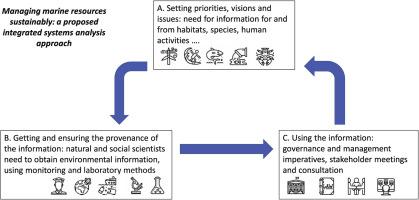当前位置:
X-MOL 学术
›
Ocean Coast Manage.
›
论文详情
Our official English website, www.x-mol.net, welcomes your feedback! (Note: you will need to create a separate account there.)
Managing marine resources sustainably: A proposed integrated systems analysis approach
Ocean & Coastal Management ( IF 4.6 ) Pub Date : 2020-11-01 , DOI: 10.1016/j.ocecoaman.2020.105315 Michael Elliott , Ángel Borja , Roland Cormier
Ocean & Coastal Management ( IF 4.6 ) Pub Date : 2020-11-01 , DOI: 10.1016/j.ocecoaman.2020.105315 Michael Elliott , Ángel Borja , Roland Cormier

|
Abstract Marine and estuarine management requires an excellent understanding of the interacting, interrelated and interdependent sub-systems comprising ecological, societal and management complexity. Managing such a complex system sustainably relies on knowing what aspects can be managed, and conversely what aspects are outside the control of the manager. Accordingly, by taking elements from existing environmental management approaches, especially in Europe and Canada, here we propose an integrated systems analysis approach which links 14 component sub-systems. Using these cases shows that while all elements exist, they have hitherto not been combined into a holistic decision support system. These components are linked here in a cycle of three Parts - (A) defining the policy problems facing the seas, (B) obtaining the relevant and fit-for-purpose natural and social sciences data and information, and (C) creating an input for policy and decision-making which involves stakeholders. The component sub-systems are: an Underpinning Framework Sub-system (1), which then leads to the Issue Sub-system (2), which is vision-related and includes causes and/or consequences of pressures to be managed. The Ecological Sub-system (3) links the biota and its environment to the Socio-ecological Sub-system (4) and the Socio-economic subsystem (5), which considers the macroeconomic aspects. The Resources and Delivery Sub-system (6) considers which scientists do what and how do they do it and the Provenance Sub-system (7) checks that there is a fit-for-purpose and defendable science evidence base. The Governance Sub-system (8), incorporates policies and politics as well as horizontally and vertically integrating the Legislative (8A) and the Administrative Sub-systems (8B). The Communication (8C) and Stakeholder Sub-systems (8D) ensure involvement across the stakeholder typology (of formal and informal actors). Finally, the Achievement Sub-system (9) and the Feedback Sub-system (10) ensures that all of these actions achieve successful and sustainable marine resource management.
中文翻译:

可持续管理海洋资源:建议的集成系统分析方法
摘要 海洋和河口管理需要对包含生态、社会和管理复杂性的相互作用、相互关联和相互依存的子系统有深入的了解。可持续地管理这样一个复杂的系统依赖于了解哪些方面可以被管理,反之,哪些方面不受经理的控制。因此,通过从现有的环境管理方法中获取元素,尤其是在欧洲和加拿大,我们在这里提出了一种集成系统分析方法,该方法将 14 个组件子系统联系起来。使用这些案例表明,虽然所有要素都存在,但迄今为止还没有将它们组合成一个整体的决策支持系统。这些组成部分在三个部分的循环中相互联系 - (A) 定义海洋面临的政策问题,(B) 获取相关且适合用途的自然科学和社会科学数据和信息,以及 (C) 为涉及利益相关者的政策和决策创造投入。组成子系统是: 基础框架子系统 (1),然后导致问题子系统 (2),它与视觉相关并包括要管理的压力的原因和/或后果。生态子系统 (3) 将生物群及其环境与考虑宏观经济方面的社会生态子系统 (4) 和社会经济子系统 (5) 联系起来。资源和交付子系统 (6) 考虑哪些科学家做什么以及他们如何做,而来源子系统 (7) 会检查是否存在适合目的且可辩护的科学证据基础。治理子系统(8),包括政策和政治,以及横向和纵向整合立法(8A)和行政子系统(8B)。沟通 (8C) 和利益相关者子系统 (8D) 确保所有利益相关者类型(正式和非正式参与者)的参与。最后,成就子系统 (9) 和反馈子系统 (10) 确保所有这些行动实现成功和可持续的海洋资源管理。
更新日期:2020-11-01
中文翻译:

可持续管理海洋资源:建议的集成系统分析方法
摘要 海洋和河口管理需要对包含生态、社会和管理复杂性的相互作用、相互关联和相互依存的子系统有深入的了解。可持续地管理这样一个复杂的系统依赖于了解哪些方面可以被管理,反之,哪些方面不受经理的控制。因此,通过从现有的环境管理方法中获取元素,尤其是在欧洲和加拿大,我们在这里提出了一种集成系统分析方法,该方法将 14 个组件子系统联系起来。使用这些案例表明,虽然所有要素都存在,但迄今为止还没有将它们组合成一个整体的决策支持系统。这些组成部分在三个部分的循环中相互联系 - (A) 定义海洋面临的政策问题,(B) 获取相关且适合用途的自然科学和社会科学数据和信息,以及 (C) 为涉及利益相关者的政策和决策创造投入。组成子系统是: 基础框架子系统 (1),然后导致问题子系统 (2),它与视觉相关并包括要管理的压力的原因和/或后果。生态子系统 (3) 将生物群及其环境与考虑宏观经济方面的社会生态子系统 (4) 和社会经济子系统 (5) 联系起来。资源和交付子系统 (6) 考虑哪些科学家做什么以及他们如何做,而来源子系统 (7) 会检查是否存在适合目的且可辩护的科学证据基础。治理子系统(8),包括政策和政治,以及横向和纵向整合立法(8A)和行政子系统(8B)。沟通 (8C) 和利益相关者子系统 (8D) 确保所有利益相关者类型(正式和非正式参与者)的参与。最后,成就子系统 (9) 和反馈子系统 (10) 确保所有这些行动实现成功和可持续的海洋资源管理。


























 京公网安备 11010802027423号
京公网安备 11010802027423号